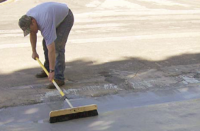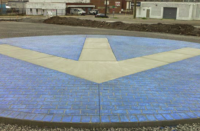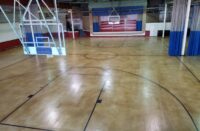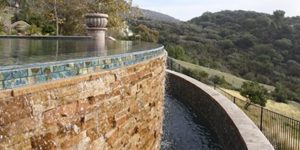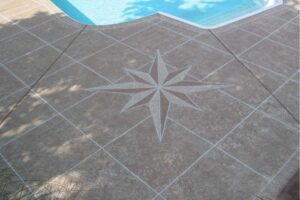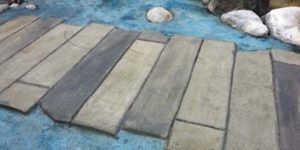
Across the country, safety surfacing products are gaining in popularity as more people discover that rubber and rubber-like granules not only feel good under the feet and cushion a fall but can also look good, too.
“It’s a neat way of treating broken concrete without ripping the surface out,” says John Schroeter, owner of Ideal Surfacing in Toronto, Ontario, who has been in the rubber safety surfacing business for three years. “A typical project takes a day or two to do and the surface is ready for use in 24 hours. And you don’t need any heavy equipment.”
He says that for his projects, he uses colorful TPV (thermoplastic vulcanized) rubber — “It’s a fabulous product that’s very UV-stable”— as well as a mix of virgin rubber and recycled tires, or just recycled tires, for people looking for a more inexpensive option. “The black rubber is more functional for a driveway or garage,” he says. “It’s a great way to revitalize asphalt or a heavily cracked concrete driveway.”
Schroeter says he learned about rubber safety surfacing when working as a general management consultant. He found the idea of mitigating risk in commercial settings attractive. “I live up North where people have plenty of chances to slip and fall,” he says. “Creating a decorative look that also had functionality intrigued me.”

Besides the obvious uses of rubber surfaces for athletic running tracks, playgrounds and water parks, he says, they work well for all sorts of applications where safety is a concern, such as entrances to
grocery stores and public buildings. Stairs that lead up to a house or down to a subway are also good candidates for rubber toppings.
Schroeter says he’s even done a number of “vanity garages,” one with an inlaid 10-foot-wide Harley-Davidson logo made out of TPV rubber. “These garages are like clubhouses,” he says. “(My clients) can comfortably walk and kneel on the floor, which doesn’t get cold.”
He’s also graced the floor of an elaborate play castle with a cobblestone pattern and “Finding Nemo” characters. Corporate logos, however, are much more common in his line of work.
Other residential uses include pool decks, especially for homes where rambunctious children live, says Rochelle Bagwell, business development manager for American Recycling Center Inc. “Some residential applicators like to use epoxy and stone mix for the garage area and then switch to the same color scheme in rubber for the patio and around the pool,” she says. “And they can make it look the same.”
Recently, there has been an increase of use of rubber in assisted living facilities projects, she adds. Rubber surfaces are suitable for common areas and patios, where stumbles could be cushioned and wheelchairs and walkers could easily glide.
“Safety surfaces are great for the elderly and little people,” Schroeter says.

EPDM vs. TPV
According to Bagwell, decorative concrete contractors already have troweling skills, so safety surfacing is a natural fit with their other flooring options. Of particular interest to those in the decorative concrete industry are two types of synthetic rubber — EPDM (ethylene propylene diene monomer) rubber and TPV. American Recycling Center sells both of these rubber granules in various sizes to an array of companies that make their own surfacing systems.
EPDM has been around for more than 20 years. Within the last 10 years, TPV was developed as an option thanks to advancements in technology. “If you were holding up a handful of each product, you would not see any difference between the two,” Bagwell says. Preference largely depends on the project, the amount of UV stability needed and the color desired. Both EPDM and TPV surfaces can be stamped with the same tools used for concrete.
EPDM and TPV granules are colored rubber polymers ground into specific sizes for the best yields during install, with the standard sizes a mix of 1-3 mm or 1-4 mm. Generally, the granules are available in 18 to 24 standard colors, which can be custom-blended during the install. Some installers, like Schroeter, offer their customers an option to add a percentage of black recycled rubber, also known as crumb rubber, to their mix.
Overall, Bagwell says, American Recycling Center’s testing has found TPV to be more UV-stable than EPDM. The company also found it offers better color consistency throughout each batch and is stronger than most EPDM products because it is pretreated with a polymer during manufacturing.
Over the last few years, lower-quality EPDM products were introduced to the marketplace, she says. They were prematurely aging and, because of that, tarnishing the topping’s reputation. “But not all EPDMs are manufactured alike,” she says. “There are still good quality EPDMs manufactured out there.” The material remains popular among some longtime users.
When TPV was first introduced, it cost more than EPDM but the price has come down over the years. “Both cost about the same now,” Bagwell says, and because of that TPV is gaining ground.
Choosing a binder Both are effective binding agents overall, but the oil in the aromatic binder tends to amber when exposed to ultraviolet light, creating a yellowish tint that many find unappealing, especially over light colors or greens and blues. The initial yellow tint isn’t as noticeable on terra cotta or browns, Bagwell adds. “On a sunny day, you can see the aromatic binder on a surface slowly amber as it starts to cure,” she says, unlike the more costly aliphatic binder that does not.
In time, the yellow color will dissipate as the aromatic binder on the top of the granules wears away. “The surface will ‘burn back’ to the color the client originally picked,” Bagwell says. The clear aliphatic topcoat also wears away, but there is no color change when it does.
“About 90 percent of the playgrounds you see are done with an aromatic binder,” she says, with the remaining 10 percent incorporating aliphatic. “The aliphatic costs twice as much and is cost-prohibitive for many large projects.”
Rounding out the choices PolySoft is available in 18 colors that can be blended to create hundreds of color combinations. The material comes in premeasured kits and is installed by certified installers to promote consistency and reliability, says Philip Baker, PolySoft’s business development manager for North America. It will adhere to most surfaces and is applied over a layer of general-purpose synthetic rubber (usually SBR) where extra cushioning is needed. PolySoft granules, he continues, are extremely resilient to UV rays, chlorine, chemicals and cleaning agents. The granules are coated with a heat-reflective layer, allowing a PolySoft surface to remain up to 70 degrees cooler than traditional rubber.
For play environments, Baker says, PolySoft can be installed as a permeable surface or as an impervious system. The impervious systems’ unique characteristics allow it to be applied vertically. “You can’t do that with rubber,” Baker notes.
The application Baker thinks is most appealing to decorative concrete installers, however, is the PolySoft broadcast system, which involves broadcasting the small PolySoft granules over the top of a layer of flexible epoxy and then sealing the surface. This method still produces a nonslip, chemical- and UV-resistant surface, he says, and is a good choice for places such as locker rooms, showers and indoor pool surrounds where you want a completely sealed solution.
“Unlike the other two systems, I wouldn’t recommend this application as a play surface in areas where kids are running around,” Baker says. “But if you need a reliable nonslip surface, it’s perfect.” North American customers for this system include Gold’s Gym, Destination Hotels & Resorts and U.S. prisons.
www.americanrecycling.com
There are basically two types of glue used to bind together safety surfacing: aromatic and aliphatic.
In addition to EPDM and TPV rubber surfacing granules, there’s an Australian newcomer that’s making headway in the safety surfacing market. Available in North America for almost two years and now also manufactured here, PolySoft is a pour-in-place surfacing solution composed of polyolefin plastomer (plastic) granules chemically bonded together with a two-part aliphatic polyurethane.
www.idealsurfacing.com
www.polysoftsurfaces.com
